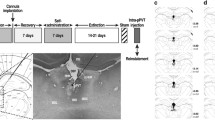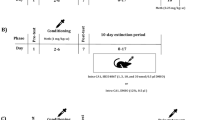Abstract
Orexins-A (OrxA) and -B (OrxB) neuropeptides are synthesized by a group of neurons located in the lateral hypothalamus and adjacent perifornical area, which send their projections to the mesolimbic dopaminergic (DAergic) system including ventral tegmental area and nucleus accumbens (NAc), where orexin receptors are expressed. NAc plays a central role in reward-seeking behavior and drug abuse. NAc-neurons express dopamine-1 (D1R) and dopamine-2 (D2R) receptors. Orexins bind to their two cognate G-protein-coupled receptors, orexin-receptor type-1 (Orx1R) and type-2 (Orx2R). Orexin receptor signaling is involved in behaviors such as motivation and addiction. Orexin-containing neurons modulate DAergic activity that is key in synaptic plasticity induced by addictive drugs. However, the effect of OrxA on expression and content of DAergic receptors in NAc is unknown. The purpose of this study was to investigate whether OrxA can alter gene expression and protein levels of D1R/D2R in NAc. Gene expression was evaluated by real-time PCR analysis and protein levels by western blot in rats. The results show that intracerebroventricular (i.c.v.) injection of OrxA increases both gene transcription and protein content of D2R but fails to modify D1R. This effect was also confirmed with OrxA infusion in NAc/Shell. Our results demonstrate for the first time that OrxA induces up-regulation of gene and protein of D2R in NAc. These findings support the hypothesis that OrxA modulates the DAergic transmission and this may serve to understand how orexin signaling enhances DA responses at baseline conditions and in response to psychostimulants.





Similar content being viewed by others
References
Mahler SV, Smith RJ, Moorman DE, Sartor GC et al (2012) Multiple roles for orexin/hypocretin in addiction. Prog Brain Res 198:79–121
Barson JR, Leibowitz SF (2016) Hypothalamic neuropeptide signaling in alcohol addiction. Prog Neuropsychopharmacol Biol Psychiatry 65:321–329
James MH, Campbell EJ, Dayas CV (2017) Role of the orexin/hypocretin system in stress related psychiatric disorders. Curr Top Behav Neurosci 33:197–219
de Lecea L, Kilduff TS, Peyton C, Gao X et al (1998) The hypocretins: hypothalamus-specific peptides with neuroexcitatory activity. Proc Natl Acad Sci USA 95(1):322–327
Sakurai T, Amemiya A, Ishii M, Matsuzaki I et al (1998) Orexins and orexin receptors: a family of hypothalamic neuropéptidos and G protein-coupled receptors that regulate feeding behavior. Cell 92(4):573–585
Zhu Y, Miwa Y, Yamanaka A, Yada T et al (2003) Orexin receptor type-1 couples exclusively to pertussis toxin-insensitive G-proteins, while orexin receptor type-2 couples to both pertussis toxin-sensitive and -insensitive G-proteins. J Pharmacol Sci 92(39):259–266
Marcus JN, Aschkenasi CJ, Lee CE, Chemelli RM et al (2001) Differential expression of orexin receptor 1 and 2 in the rat brain. J Compd Neurol 435(1):6–25
Peyron C, Tighe DK, van den Pol AN, de Lecea L et al (1998) Neurons containing hypocretin (orexin) project to multiple neuronal systems. J Neurosci 18(23):9996–10015
Harris GC, Wimmer M, Aston-Jones G (2005) A role for lateral hypothalamic orexin neurons in reward seeking. Nature 437(7058):556–559
Narita N, Nagumo Y, Hashimoto S, Narita M et al (2006) Direct involvement of orexinergic systems in the activation of the mesolimbic dopamine pathway and related behaviors induced by morphine. J Neurosci 26(2):398–405
McDevitt DS, Jonik B, Graziane NM (2019) Morphine differentially alters the synaptic and intrinsic properties of D1R- and D2R-expressing medium spiny neurons in the nucleus accumbens. Front Synaptic Neurosci 20(11):35
Neve KA, Seamans JK, Trantham-Davidson H (2004) Dopamine receptor signaling. J Recept Signal Transduct Res 24(3):165–205
De Mei C, Ramos M, Iitaka C, Borrelli E (2009) Getting specialized: presynaptic and postsynaptic dopamine D2 receptors. Curr Opin Pharmacol 9(1):53–58
Beaulieu JM, Gainetdinov RR (2011) The physiology, signaling, and pharmacology of dopamine receptors. Pharmacol Rev 63(1):182–217
Meiergerd SM, Patterson TA, Schenk JO (1993) D2 receptors may modulate the function of the striatal transporter for dopamine: kinetic evidence from studies in vitro and in vivo. J Neurochem 61(2):764–767
Lee FJ, Pei L, Moszczynska A, Vukusic B et al (2007) Dopamine transporter cell surface localization facilitated by a direct interaction with the dopamine D2 receptor. EMBO J 26(8):2127–2136
Dickinson SD, Sabeti J, Larson GA, Giardina K et al (1999) Dopamine D2 receptor-deficient mice exhibit decreased dopamine transporter function but no changes in dopamine release in dorsal striatum. J Neurochemistry 72(1):148–156
España RS, Oleson EB, Locke JL, Brookshire RBR et al (2010) The hypocretin–orexin system regulates cocaine self-administration via actions on the mesolimbic dopamine system. Eur J Neurosci 31(2):336–348
España RA, Melchior JR, Roberts DCS, Jones SR (2011) Hypocretin 1/orexin A in the ventral tegmental area enhances dopamine responses to cocaine and promotes cocaine self-administration. Psychopharmacology 214(2):415–426
Quarta D, Smolders I (2014) Rewarding, reinforcing and incentive salient events involve orexigenic hypothalamic neuropeptides regulating mesolimbic dopaminergic neurotransmission. Eur J Pharm Sci 57:2–10
Vittoz NM, Berridge CW (2006) Hypocretin/orexin selectively increases dopamine efflux within the prefrontal cortex: involvement of the ventral tegmental area. Neuropsychopharmacology 31(2):384–395
Moorman DE, Aston-Jones G (2010) Orexin/hypocretin modulates response of ventral tegmental dopamine neurons to prefrontal activation: diurnal influences. J Neurosci 30(46):15585–15599
Prince CD, Rau AR, Yorgason JT, España RA (2015) Hypocretin/orexin regulation of dopamine signaling and cocaine self-administration is mediated predominantly by hypocretin receptor 1. ACS Chem Neurosci 6(1):138–146
Korotkova TM, Sergeeva OA, Eriksson KS, Haas HL et al (2003) Excitation of ventral tegmental area dopaminergic and non-dopaminergic neurons by orexins/hypocretins. J Neurosci 23(1):7–11
Bogland SL, Taha SA, Sarti F, Fields HL et al (2006) Orexin A in the VTA is critical for the induction of synaptic plasticity and behavioral sensitization to cocaine. Neuron 49(4):589–601
Borgland SL, Storm E, Bonci A (2008) Orexin B⁄hypocretin 2 increases glutamatergic transmission to ventral tegmental area neurons. Eur J Neurosci 28(8):1545–1556
Estabrooke IV, McCarthy MT, Ko E, Chou TC et al (2001) Fos expression in orexin neurons varies with behavioral state. J Neurosci 21(5):1656–1662
Fadel J, Deutch AY (2002) Anatomical substrates of orexin-dopamine interaction: lateral hypothalamic projections to the ventral tegmental area. Neurosci 111(2):379–387
Chen Y-W, Morganstern I, Barson JR, Hoebel GB et al (2014) Differential role of D1 and D2 receptors in the perifornical lateral hypothalamus in controlling ethanol drinking and food intake: possible interaction with local orexin neurons. Alcohol Clin Exp Res 38(3):777–786
Paxinos G, Watson C (2007) The rat brain in stereotaxic coordinates, 6th edn. Academic Press, San Diego
Magdaleno-Madrigal VM, Morales-Mulia S, Nicolinic H, Genis-Mendoza A et al (2019) Orexin-A promotes EEG changes but fails to induce anxiety in rats. Behav Brain Res 361:26–31
Charuchinda C, Supavilai P, Karobath M, Palacios JM (1987) Dopamine D2, receptors in the rat brain: autoradiographic visualization using a high-affinity selective agonist ligand. J Neurosci 7(5):1352–1380
Lidow MS, Goldman-Rakic PS, Innis RB (1989) Dopamine D2 receptors in the cerebral cortex: distribution and pharmacological characterization with [3Hlraclopride. Proc Nat Acad Sci USA 86(16):6412–6416
Landwehrmeyer B, Mengod G, Palacios JM (1993) Differential visualization of dopamine D2 and D3 receptor sites in rat brain. A comparative study using in situ hybridization histochemistry and ligand binding autoradiography. Eur J Neurosci 5(2):145–153
Cataldi NI, Lux Lantos VA, Libertun C (2014) Orexin A and B in vitro modify orexin receptors expression and gonadotropins secretion of anterior pituitary cells of proestrus rats. Regul Pept 188:25–30
Liu Y, Zhao Y, Ju S, Guo L (2015) Orexin A upregulates the protein expression of OX1R and enhances the proliferation of SGC-7901 gastric cancer cells through the ERK signaling pathway. Int J Mol Med 35:539–545
Gallo EF, Salling MC, Feng B, Morón JA et al (2015) Upregulation of dopamine D2 receptors in the nucleus accumbens indirect pathway increases locomotion but does not reduce alcohol consumption. Neuropsychopharmacology 40(7):1609–1618
Giordano TP III, Satpute SS, Striessnig J, Kosofsky BE et al (2006) Up-regulation of dopamine D2L mRNA levels in the ventral tegmental area and dorsal striatum of amphetamine-sensitized C57BL/6 mice: role of Cav1.3 L-type Ca2+ channels. J. Neurochem 99(4):1197–1206
Acknowledgements
This work was supported by the Consejo Nacional de Ciencia y Tecnología (CONACYT 241216) and the Instituto Nacional de Psiquiatría Ramón de la Fuente Muñíz (IC16033.0). We acknowledge Mr. José Manuel Pérez Luna for his technical assistance.
Author information
Authors and Affiliations
Contributions
Dr. Sandra Morales-Mulia, conducted the gene expression experiments, writing and discussion of the article. Dr. Víctor Manuel Magdaleno-Madrigal, performed the animals and administered the treatments. Dr. Humberto Nicolini and Dr. Alma Genis-Mendoza provided the necessary infrastructure for gene expression experiments. Dr. Marcela Morales-Mulia, conduced the protein levels experiment, writing and discussion of the article.
Corresponding author
Ethics declarations
Conflict of interest
All authors declare that there are no conflicts of interest.
Additional information
Publisher's Note
Springer Nature remains neutral with regard to jurisdictional claims in published maps and institutional affiliations.
Rights and permissions
About this article
Cite this article
Morales-Mulia, S., Magdaleno-Madrigal, V.M., Nicolini, H. et al. Orexin-A up-regulates dopamine D2 receptor and mRNA in the nucleus accumbens Shell. Mol Biol Rep 47, 9689–9697 (2020). https://doi.org/10.1007/s11033-020-05979-2
Received:
Accepted:
Published:
Issue Date:
DOI: https://doi.org/10.1007/s11033-020-05979-2




